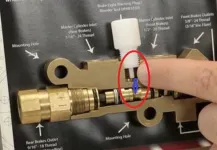Brakes 1980 CJ7 Front Brake Bleeding Issue
inthegarage
Jeeper
I have a 1980 CJ7 with standard brakes, disk front/drum rears. I just finished replacing the entire brake system, lines, wheel cylinders, calipers, etc.
I cannot get the front calipers to move or feel any pedal pressure for the front brakes. The pedal goes easily 1/2 through its travel then gets very hard. The rear brakes work very well.
The first time I bleed the system, I had the original combination valve installed (W-Type). By pulling on the pin in the front, I was able to get a little pressure in the fronts, but as soon as I released the pin, no pressure again. The pin is brass and eventually I muitlated it so much, I couldn't grab it anymore. I bought a new PV2 valve (looks identical externally) with the bleeding tool that installs where the brake warning sensor goes, but had the same issue. Back brakes work great, but nothing from the front. Purchased another PV2 valve and have the same result. I see fluid at all four corners and bleeding seems normal. Every time I've introduced air I see bubbles, but can bleed enough to get back to pure fluid. I've followed the sequence from the back passenger, back driver, front passenger, front driver.
Besides pulling the pin in the original combination valve, I haven't been able to get any pressure in the first 1/2 of pedal travel and the calipers are not moving. The new PV2 valves don't seem to have the same pin in the front (there is less to grab on) so I haven't been able to pull that pin for the second two attempts. All of the literature I can find seems to indicate if you use the bleeding tool for the PV2, you don't need to mess with the pin in the front.
I have no idea what to try next, has anyone run into a similar problem or have any suggestions? Anyone switch to a different combination valve with success?
I cannot get the front calipers to move or feel any pedal pressure for the front brakes. The pedal goes easily 1/2 through its travel then gets very hard. The rear brakes work very well.
The first time I bleed the system, I had the original combination valve installed (W-Type). By pulling on the pin in the front, I was able to get a little pressure in the fronts, but as soon as I released the pin, no pressure again. The pin is brass and eventually I muitlated it so much, I couldn't grab it anymore. I bought a new PV2 valve (looks identical externally) with the bleeding tool that installs where the brake warning sensor goes, but had the same issue. Back brakes work great, but nothing from the front. Purchased another PV2 valve and have the same result. I see fluid at all four corners and bleeding seems normal. Every time I've introduced air I see bubbles, but can bleed enough to get back to pure fluid. I've followed the sequence from the back passenger, back driver, front passenger, front driver.
Besides pulling the pin in the original combination valve, I haven't been able to get any pressure in the first 1/2 of pedal travel and the calipers are not moving. The new PV2 valves don't seem to have the same pin in the front (there is less to grab on) so I haven't been able to pull that pin for the second two attempts. All of the literature I can find seems to indicate if you use the bleeding tool for the PV2, you don't need to mess with the pin in the front.
I have no idea what to try next, has anyone run into a similar problem or have any suggestions? Anyone switch to a different combination valve with success?

